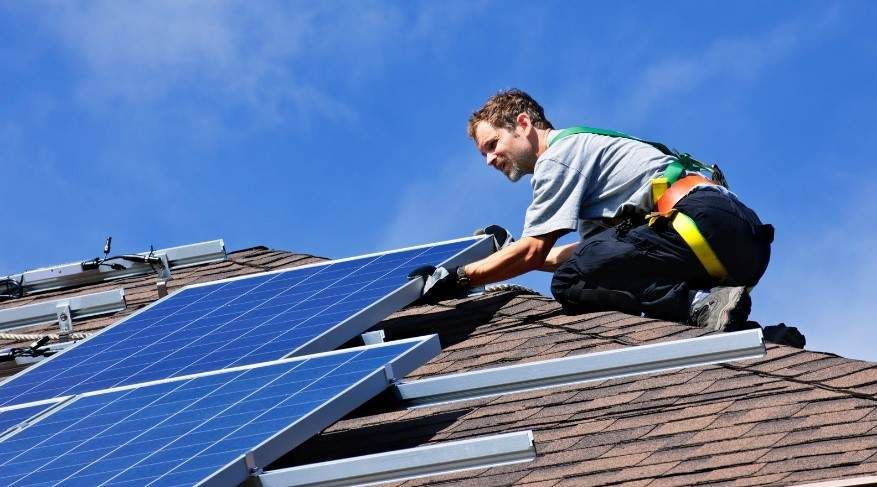Abbotsford Solar Installation
Can You Install Solar In A Multi-House Compound in Abbotsford?
The concept of community is flourishing, with multi-house compounds gaining popularity across Canada. These shared living arrangements offer an opportunity to explore sustainable solutions like solar power.
Abbotsford enjoys an average of 1876 sunshine hours annually, making it a good location for solar power generation.
Modern solar panels have an efficiency rating between 18% and 22%. System design software factors in shading and tilt angle to estimate the expected annual electricity production. Analyzing historical electricity bills from each participating house establishes the baseline consumption patterns, which is necessary for sizing the solar system from “solar system installers near me.”
Solar Access
The unobstructed availability of sunlight on a surface is important for solar power generation systems. The amount of solar radiation a photovoltaic (PV) panel receives directs to its electricity output.
Key Metrics
| Solar Irradiance | Represents the amount of solar energy striking a surface per unit area. Understanding the average daily, monthly, and yearly irradiance levels at a specific location is essential for predicting energy production. |
| Sun Path Analysis | Solar access tracks the sun's apparent movement across the sky throughout the year. Software tools and online resources generate sun path diagrams for a specific location. Illustrating the sun's altitude and azimuth angles at different times of the day and throughout the year. |
| Shading Analysis | Identifying and mitigating shading sources optimizes solar access. Shading comes from surrounding buildings, trees, and other structures. Site surveys and software simulations help analyze shading patterns on the proposed PV panel array throughout the day and year. |
Factors
Roof Orientation and Pitch
The ideal orientation for solar panels in Abbotsford is a south-facing roof, as it receives the most direct sunlight throughout the year. However, east-facing and west-facing roofs still generate substantial solar energy. The roof pitch, or angle of inclination, also impacts solar access. A roof pitch between 18° and 36° is considered optimal for energy consumption at most latitudes in Canada.
Installation Approach
Solar panel installation adheres to strict safety protocols outlined by the Canadian Standards Association (CSA) for Photovoltaic (PV) Systems. Including fall protection measures for workers on rooftops, proper electrical safety procedures, and ensuring all equipment complies with safety certifications.
Mounting System Selection
Ballasted Mounting Systems
- Well-suited for flat roofs with a parapet wall for added stability.
- Concrete paver blocks are typically used to weigh down the mounting system and secure the panels.
- Offers easy installation and minimal roof penetration, minimizing potential leaks.
- Additional weight calculations are required to ensure the paver blocks withstand wind loads specific to Abbotsford's climate zone.
Tilt-up Mounts
- Ideal for pitched roofs (typically between 18° and 36°) for optimal sunlight capture in Abbotsford's latitude.
- Utilizes L-shaped metal brackets that are anchored to the roof trusses through the roof deck.
- Offers a stable and safe mounting solution for angled roofs.
- Requires careful roof penetration planning and proper flashing installation to prevent water leaks.
Roof Hook Mounts
- Designed for specific types of roof materials like composition shingles or metal roofs.
- Hooks are secured directly to the roof rafters underneath the shingles or integrated with the standing seam of a metal roof.
- Offers a low profile and aesthetically pleasing appearance.
- Requires expertise for proper installation to ensure waterproofing integrity and minimize roof penetration points.
A 4-House Compound in Abbotsford
Consider a 4-house compound in Abbotsford with a combined roof area suitable for a 10 kW solar system. The roof compositions vary across the houses:
House 1
Flat roof with a parapet wall (suitable for ballasted mounts)
Houses 2 & 3
South-facing pitched roofs (18° angle) (suitable for tilt-up mounts)
House 4
Metal roof (suitable for roof hook mounts)
In this scenario, a combination of mounting systems would be utilized:
- Ballasted mounts on the flat roof of House 1.
- Tilt-up mounts on the south-facing pitched roofs of Houses 2 & 3, optimized for an 18° tilt angle to maximize sun exposure in Abbotsford.
- Roof hook mounts are specifically designed for metal roofs on House 4.
System Sizing
The number of residents in each house and their appliance usage patterns influence overall electricity consumption. Factors like pool pumps, air conditioning systems, and electric vehicle charging need to be considered for an accurate assessment.
Obtaining historical electricity bills from each house within the compound provides valuable data on past electricity consumption patterns. This data reveals monthly and yearly usage trends, hence will determine the overall electricity demand of the compound.
Electrical Installation
This involves running cables from each solar panel to a combiner box, which collects the DC electricity from all panels. The inverter(s) converts the DC electricity to AC electricity compatible with the grid. All electrical connections are meticulously installed and rigorously tested to ensure safety and proper operation.
System Commissioning and Inspection
Upon completion of the installation, a comprehensive system commissioning is performed. This verifies the functionality of all components, ensures proper grid interconnection, and tests for safety compliance. FortisBC requires a final inspection before the system can be activated and begin generating electricity.
System Costs for Multi-House Solar Installations
Equipment Costs
- Installing Solar panels: $2.50 - $3.00 per watt (Wp)
- Inverters: $0.50 - $1.00 per Wp (depending on system size and type)
- Mounting system: $0.50 - $1.00 per Wp (varies based on roof type and complexity)
- Balance of system (BOS) components: $0.50 - $1.00 per Wp (includes wiring, conduit, combiner box, and other electrical components)
Permitting and Inspections
$1,000 - $5,000 (depends on project complexity and number of permits required)
Engineering Fees
$1,000 - $5,000 (depends on the need for structural analysis and engineering drawings)
Installation Labor
$1.00 - $2.00 per Wp (varies based on system size, roof accessibility, and labour rates)
Solar Panels Cost Calculation for a 10 kW System
- Equipment Costs:
- Install Solar Panels (10 kW x $2.75/Wp) = $27,500
- Inverter (10 kW x $0.75/Wp) = $7,500
- Mounting System (10 kW x $0.75/Wp) = $7,500
- Balance of System (10 kW x $0.75/Wp) = $7,500
- Subtotal Equipment = $50,000
- Permitting & Inspections = $3,000
- Engineering Fees = $2,000
- Installation Labor (10 kW x $1.50/Wp) = $15,000
- Total System Cost = $70,000
Gauging Interest from Residents
Understanding Resident Motivations
| Cost Savings | Highlighting significant reductions in electricity costs through shared solar generation is a powerful motivator. Provide estimates of projected savings based on historical electricity consumption data from each house. |
| Environmental Benefits | Emphasize the environmental advantages of how much energy is produced, including reduced greenhouse gas emissions and a cleaner energy source for the compound. |
| Increased Property Value | Studies suggest properties with solar panels command a higher selling price. This can be an attractive benefit for residents considering future home sales. |
| Energy Independence | Offers a degree of independence from fluctuating grid electricity prices, which appeals to residents seeking greater control over their energy costs. |
Effective Communication Strategies
- Organize informational meetings to introduce the concept of shared systems. Present the benefits, address concerns, and answer resident questions in a clear and comprehensive manner.
- Develop financial models that illustrate the projected cost savings for each household based on individual electricity consumption patterns.
- If possible, arrange site visits to nearby multi-house compounds with existing installations. This allows residents to see a functioning system firsthand and speak with current users about their experiences.
- Conduct surveys to gauge resident interest and gather feedback on concerns. This feedback can be used to tailor communication strategies and address specific questions or hesitations to produce solar energy.

Harnessing the Sun in a Multi-House Compound
Transitioning a multi-house compound to solar photovoltaic power requires planning, considering feasibility, resident engagement strategies, and financial considerations.
By assessing solar access, selecting appropriate mounting systems, and designing an optimized electrical installation, a shared solar panel system opens doors for significant cost savings.
Contact Abbotsford Solar Installation today for a free consultation and explore the possibilities of a shared solar solution tailored to your compound's specific needs.
Frequently Asked Questions
What are the different types of metering configurations for a multi-house solar system?
There are two main options:
- Shared Metering: The entire system's production offsets the collective electricity consumption of all houses in the compound. This approach simplifies billing but requires fair allocation of cost savings based on individual consumption patterns.
- Individual Metering: Each house within the compound maintains its own meter. Solar production offsets individual consumption, and any excess can be credited back to the grid under net metering programs offered by BC Hydro.
Are there financial incentives available to offset the cost of a solar system in Abbotsford?
Yes, government incentives through programs like the Canada Greener Homes Grant can help reduce the upfront cost of a solar system by up to $40,000. Additionally, net metering programs offered by FortisBC allow earning credits for excess energy exported back to the grid.
How does snow accumulation affect renewable energy production in Abbotsford?
Abbotsford experiences moderate snowfall. While snowfall temporarily reduces energy production, most solar panels have a tilted angle that allows snow to slide off naturally. Heated cables can be installed on the panels in areas prone to heavy snowfall to maintain optimal performance throughout winter.
